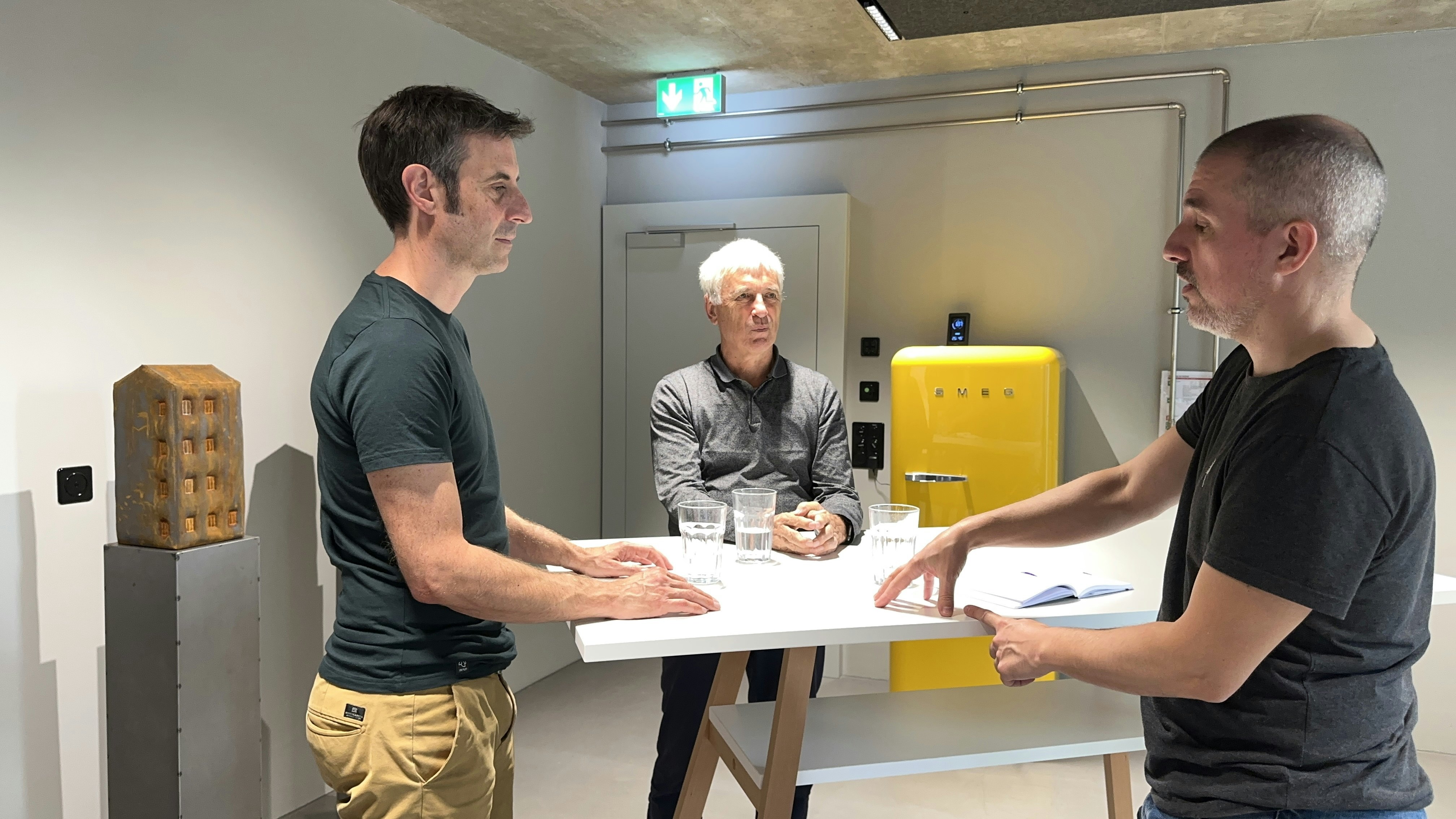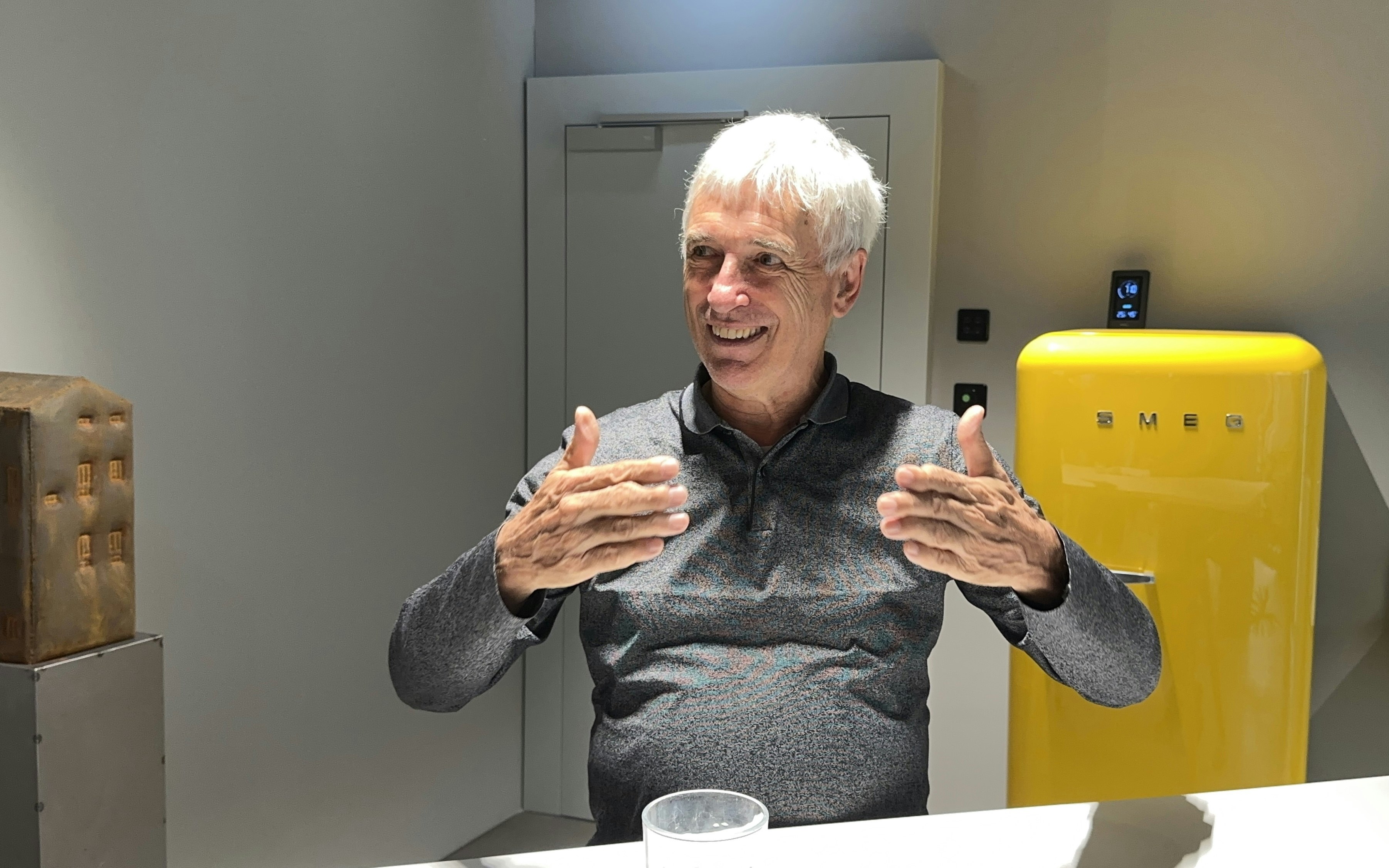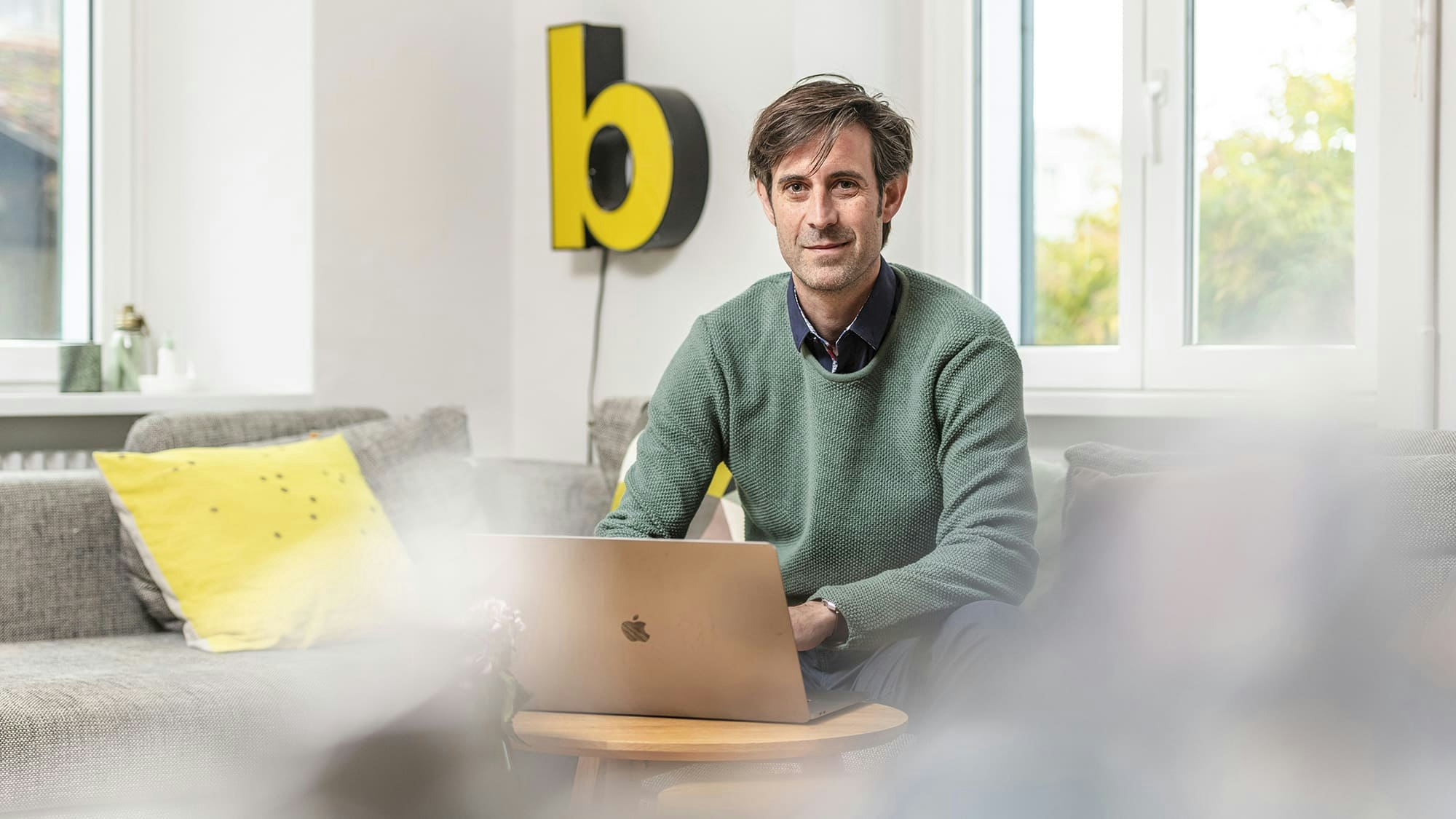A common language in the company: Stefan Berner and Christian Bühlmann talk about information cartography and their book – Part 1 of 2

The two consultants of foryouandyourcustomers, Stefan Berner and Christian Bühlmann, wrote a book on information cartography last year. Those who read the book will not only get an introduction to the theory of information modelling and information cartography, but a practical guide on how to use the methods beneficially in a company. In the first part of the talk, the authors discuss information cartography as a method. In the second part, they tell what effect the book writing has had on their understanding of the method and their work with clients.
Using information modelling and information cartography to achieve a common language in the company
You have been working on your book on information cartography for around a year. What is information cartography about?
Bühlmann: To explain information cartography, we have found a nice analogy. It starts with expeditions. Hundreds of years ago, expeditions were journeys into the unknown. Many missions failed, there were deaths, ships and treasures sank to the bottom of the sea. Despite failures, people always explored the world. One of these explorers was Alexander von Humboldt. Among other things, he travelled through South America, sketched maps and carried out botanical and other field studies. The sketches and notes he brought back home were entered by cartographers into the existing world map and helped to make the new knowledge accessible to a wider circle of users by publishing maps.
With information cartography, it is actually the same: in the project context, an information model is created – a map, a sketch of a sub- or specialist area in a company. With information cartography, we embed the knowledge in the overall company knowledge and link it with other knowledge elements. We can prepare it in such a way that there is a recognition effect with the readers, like with terrain maps, and so they can work efficiently with the knowledge.
That is the competence of information cartography. It uses the elements of classical cartography that have been established over time and helps to capture, design, manage and disseminate corporate knowledge. Knowledge alone does not help a company; it must be effectively transformed into value through employee actions. Ultimately, it is about having the maps ready in the company before the journey starts. Thanks to good maps, projects are no longer expeditions into the unknown.
„Knowledge alone does not help a company; it must be effectively transformed into value through employee actions.“ Christian Bühlmann
If a company has map material, I assume that it has to continue to maintain it - similar to the national topography, where people take care of the maintenance of the map data.
Bühlmann: Unlike the physical world, the digital world is much more volatile. The cartography of digital systems has a higher rate of change. The business units and the business model, on the other hand, do not change as quickly, but these also need to be maintained. Especially when companies merge or expand business activities, they need to update the model.
Berner: It works similarly to normal maps. There are basics like mountains, rivers, and lakes that you can't change that quickly, and there are moving things like bridges, roads, cities, and forests that you can change more quickly. If you want to plan a trip, you have to know where there is a bridge; if you want to build a bridge, you have to know who lives on the other side or if there is a mountain.It's precisely the same in business: You have stable things that change extremely slowly, but you also have things that change quickly and affect the whole company or society. You have different levels of speeds, which is why you need different types of documentation. The basic map should remain stable. But the more you go into use, the more volatile the whole thing becomes and the faster you have to react – re-document, maintain, keep up to date. This requires an organisation that describes the basis for the work as an infrastructure organisation.
Bühlmann: In addition to the up-to-dateness and thus reliability of the map material, continuity is crucial: What good are two map sheets if there is no recognisable connection between them? If the paths stop at the edge? My understanding remains fragmented if the products are disconnected from the customers and the suppliers.
So a company does not only have a basic map. How are the map sections related?
Berner: The idea is that you can zoom down from the whole company to one department, project or area. But you can also cross over to the next area and find the same basics because they are described similarly. In the past, each cartographer used their scale system; you couldn't compare the systems with each other. By standardising this in cartography to one or two models that are compatible with each other, contributions can be used by others. The silo thinking that everyone makes and masters their own descriptions must be broken down. Knowledge has to become cross-divisional and cross-departmental. Only then will the entire company benefit.
Stefan Berner talking about Information Cartography

Is this where the information model comes into play as a descriptive language?
Berner: Information modelling – my first book – provides a basis, a language and a method for documenting knowledge in a unified form. It is both technically and mathematically coherent as well as readable for IT laypersons. The information model provides a description that everyone can relate to. It is nevertheless so exact that the model can bring together descriptions from several people. The descriptions do not have to be identical, but they can at least be matched or linked. The model comes from relational database programming but is extended for communication in an IT layperson's environment.
The common language of the model corresponds to the projection, coordinate system and symbols of cartography. This must be agreed upon so that a map can be read worldwide. The symbols on the map must be clearly standardised and defined, and their arrangement or colouring determined so that another person can read and work with the map.
Information cartography and information model sound like abstract methods. If a company wants to use them, it obviously needs more than just a map. What does a company need to apply them successfully?
Bühlmann: It takes surprisingly little. It takes one person who masters the survey method and can collect the information from the employees.
Berner: The Humboldt, so to speak.
Bühlmann: Exactly. The person who walks around with the collection basket, asks the right questions and records the answers that are available in the company. However, the role also includes structuring and publishing the found knowledge in map form. There is not just one map but different map representations, including existing representations, which you just have to connect. This is the cartographer’s role, the Mercator in the company, as it were.
„The method works on a small scale, but its effect only unfolds when it can work on a large scale.“ Stefan Berner
Berner: We talk about an information map of the company. What is also needed is an understanding that communication and a common language have value. If you want to work on or use something together, you need a common language to communicate about it. This requires that the role of the person Christian was talking about is not located far down in one area of the organisation. It must have a cross-sectional function, not be concerned with individual topics, areas or locations, but with the company's overall picture. That is one of the big sticking points. Such positions are rare in today's companies because most are organised hierarchically. This awareness or willingness to create an organisation with such a corporate value is a prerequisite for information mapping to work at all – for the company. One can also start small and create a map for a project. It only becomes a 'world map' when you can talk to your neighbour on another project. The method works on a small scale, but its effect only unfolds when it can work on a large scale.
Which companies benefit most from the method?
Bühlmann: It can already make a difference in a small team. But if people talk to each other every morning in the kitchens, as in a start-up, then the mental images of the employees align with each other anyway. As soon as a spatial or organisational separation begins, you need a means of communication. Information modelling and cartography are good tools to put aside the technical view and talk to each other only on the content level across organisational and spatial boundaries
„Information modelling and cartography are good tools to put aside the technical view and talk to each other only on the content level across organisational and spatial boundaries.“ Christian Bühlmann
Would you say that until now most companies of a certain size and organisational structure did not have a common language?
Berner: Some companies are doing this well. But we are not asked for support from them. I think newly started IT companies have it very well under control. You can tell by the kind of services they provide. We are seeing that many companies do have a terminology and glossary database and maintain certain terms. But the communication and use of these glossaries are rather modest. There is a lack of common understanding that they need to agree on a term and not all use their own understanding in their day-to-day work, without regard to directives. There is a lack of understanding that existing knowledge, some of which has already been described, is brought together, maintained and communicated as company knowledge. It must not happen that after the end of the project, the terminology database disappears again. We notice that the long-term view is missing in most companies.
Bühlmann: And there are the interpreters and silverbacks who know everything and perhaps sometimes combine the professional knowledge across two departments in one person. Then you are dependent on that person.
Berner: They make sure that what one department produces, the other sells properly. It is not the technical processes that ensure this but the people who sit at the interface and have the relevant knowledge. These people are overburdened with too many tasks and are overtaxed. When they leave the company, the knowledge is lost. We want to document this knowledge and make it accessible to everyone – step by step. By the way, this is not a task that can be done in one go. You can't pick up the knowledge in a company today and document it tomorrow. But you have to start somewhere
So you don't impose anything on a company and tell it what to do. They have to find out for themselves using the method.
Bühlmann: The company itself must realise that easily accessible knowledge and thus understanding has value, even if it cannot be directly calculated in material terms. Information mapping is a simple method because it does not dictate to people. It is not like a governance corset, which brings a kind of law book with clear rules.
Berner: We say very clearly that we do not have a solution for our clients. However, we help them to build the solution that fits them. They have to build the knowledge; we support them with the basic method and rules of the models and the procedure. What comes out of it, we do not prescribe.
The method is to be brought to life in a day-to-day business that has time not only for the new but also for the existing. There are different starting points for this. For example, when a CEO says he wants such a model, top-down. We have also already started a project where we supported data mapping, that is, bottom-up. With this approach, we ensure that it is suitable for a company and not dictated from the outside. The company should bring information cartography to life in their world with their ideas and possibilities and let it become bigger.
We have seen that the method scales. You can start in different places and, if you do it right, continue in any direction – bottom-up, top-down, across. It is always the big picture that is expanded. It's not arbitrarily different places where you do something; everybody is working on the same core model from different starting points. And that's what we want to describe with information cartography: How can we bring a good method to practical use that benefits the company?
„The company should bring information mapping to life in their world with their ideas and possibilities and let it become bigger.“ Stefan Berner
Bühlmann: The method requires commitment: First, you must deal with a topic and agree on the terminology. That is work; it doesn't just happen. Dissemination is again work, namely training new staff or those who were not in the workshop.
Berner: We currently have a case where one company has bought another. Now they want to merge the two companies. Two cultures and languages collide, although they use the same IT tools in the background. We therefore have to bring them together in terms of translation and culture. This is not a technical task but a communicative, social task that has to be done in this case. First talk about it, find out, agree and then adapt to each other. These are the consequences of information cartography. Cartography only points out. We don't make solutions in cartography; we draw the map as it is today. How a company deals with the map or what bridges it builds lies in the future.
Does that mean that you will work everything out again from scratch with the acquired company, or is it just a matter of looking at what is already there and how you can match it up?
Berner: The latter. What we have worked out is verified again and then compared with what comes along – the languages, the requirements, and the solutions. Even if the new company has to adapt one hundred per cent, the effort is worth it because then we have at least the training documents in place. If we know what the differences are, we can either change an existing solution or we can provide training. So we are not telling them what to do. We just say there is a difference. This is what it looks like, this is what it could look like, and this is what it looks like for the others. What you do with it is another step again. Cartography is only the basis for that.
Are there aspects that you say a company needs to pay particular attention to when using information cartography?
Bühlmann: The company has to be careful that it reaches the users. There are domain models or architectural drawings and other things in almost every company that were good and valuable for the moment and for the people who knew about them. The models then disappeared again. They would actually still be useful, but you can no longer find the knowledge, the information. It is essential that the user group knows what can be found in the information model and how to read and apply it.
Berner: Because the information model originally comes from IT and the whole thing smells like a data model, it feels like it belongs in the IT department. For this reason, it is delegated to IT. But those who programme and maintain data are not the ones who have to work with it. It is crucial to involve the business side, those who use the data or information, at least as much, if not more than the IT department. Maybe the latter could handle it, but they are the wrong people because they are not involved in the day-to-day business. You have to reach out to the experts with the model.
Bühlmann: It is important, as Stefan said at the beginning, that information cartography serves the purpose of the company and not a particular interest. If you put it too low down in the organisation, for example, in a project, then you have the feeling that the benefit has been achieved with the end of the project and then it doesn't go any further. The container in which the plant can grow into a tree must have enough space high up in the company. But the tree sprouts in the pot, in a manageable project context.
Berner: As with Humboldt's travels, who was financially supported by the government, among others, there also needs to be a sponsor in the company who is above the daily hassles of the organisation. This sponsor must be located high up in the organisation. It must not be a project, a department or a group of people, but the whole company must be kept in mind. Information cartography cannot be done from within departmental structures. Someone high up must be a sponsor and put their heart and soul into it. You have to find such a person. Otherwise, you quickly reach the boundaries of organisational areas, competencies and responsibilities that throw a spanner in the works and where there might be no interest in communicating better with each other. It is precisely these boundaries that information cartography should cross to establish a shared, useful language in the company.
Read in the second part of the interview why Stefan Berner and Christian Bühlmann wrote the book together and what effect the intensive examination of the topic has had on their understanding of the methods and their consulting work.
For more information on this topic check LinkedIn or visit the website Information Cartography.

Christian Bühlmann
bue@foryouandyourcustomers.com
Establishes information cartography within companies and supports them in their digital change.

Stefan Berner
stb@foryouandyourcustomers.com
Accompanies customers on their way to a better understanding and a better use of their knowledge and information.